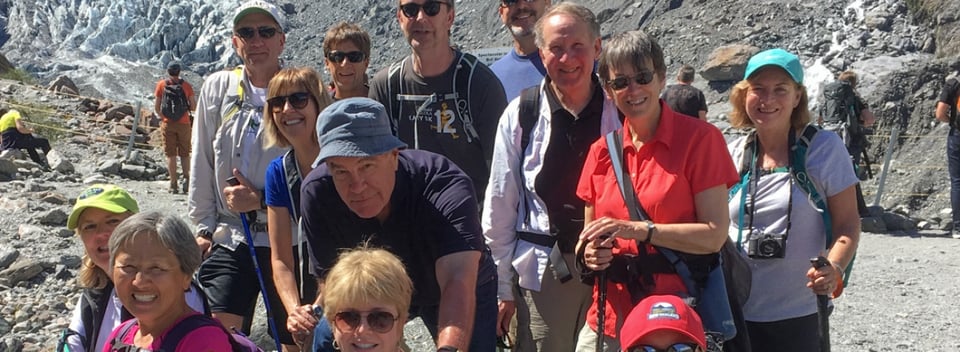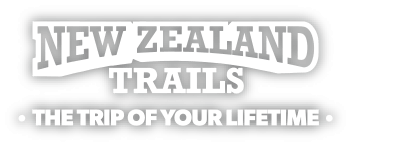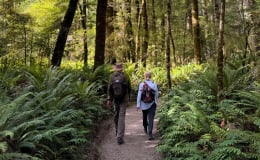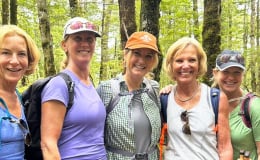
My New Zealand Trails 'World Heritage Walking Tour' – Part 3
Naturalists, Weka eating Wetas and some fine Central Otago wine - Susan Patterson continues her journey with husband Tom and shares with us their experiences of days 6, 7 and 8 on their 13-Day New Zealand 'World Heritage Walking Tour'.
My New Zealand Trails 'World Heritage Hiking Tour' - Part 3
Day 6
I cannot begin to do justice to the terrific naturalists whom Andrew has engaged along the way to hike with us and teach us about the unique flora and fauna of their area of New Zealand. Today was a great example. We joined a naturalist named Chris a for a boat cruise on Lake Wanaka followed by a nature walk on Mou Waho Island Nature Reserve, close to the center of the lake. A remnant of the last ice age, the island has been “reclaimed” – all invasive plants, trees and animals removed or killed (and continually guarded against since stoats can swim that far out from the mainland). Thus the bird life has no predators on the island and fly and alight right next to you.
We hiked for three hours with the charismatic and non-stop talking Chris, constantly telling us about each type of plant, tree, gecko, lizard, and bird we encountered. Two stand out: the flightless Buff Weka (extinct on mainland NZ) has been reintroduced here and is doing well. They are everywhere and walk right up to you. The Weta insect (like a large and even uglier grasshopper) is also extinct except for here. But Wekas eat Wetas so Chris got the Wanaka industrial arts teacher to have his students make “motel boxes” for the nocturnal Wetas to sleep in during the day to protect them from the Wekas. Very cool. We opened a few boxes and held one, as well as several skinks, lizards and geckos. This glacial island is over 600 feet high; we climbed to the top where there is a small glacial lake and had tea and biscuits overlooking the small lake, huge Lake Wanaka, and the towering alps all around. Way high across the lake we could just make out dots of sheep (thousands) grazing on a huge sheep and cattle station that is only reached by helicopter.

Our local guide on Mou Waho Island.
Over our morning tea on the cliff, Chris talked about early Maori life. All this education is like reading Bill Bryson’s A Short History of Nearly Everything, which I highly recommend. It is fascinating, but just like reading the book, I cannot retain everything I learn – in fact probably only a small percentage. I’m interested in it all, but find the people stories stay with me more than the biology does. I’m quite fascinated by how the Polynesians managed to sail thousands of miles to inhabit new islands (Chris said coconuts were the key since they have juice inside them.) Because NZ greenstone has been found on Easter Island we know the Maori traveled there. They used the very hard greenstone for cutting and spear tips.
Actually, the very first Polynesians who came to NZ were not Maori and were pacifists. When the Maori arrived, they forced the first group to retreat to the Fiordland area, and then chased them down and wiped them completely out. The Maori were ferocious warriors who fought each other’s’ tribes and tortured and cannibalized even the children of their enemies. It’s a low blow for my hopes for human nature, that evidently being pacifist minimizes your chances of survival and continuation of your culture. Every trip out to the island, Chris plants a native tree with his clients. We planted a Totara tree which will grow to be great bird cover and is also the kind of wood used for Maori carvings. This season has been very dry so Chris also brings water up the trail to nourish previous plants.

Exploring Mou Waho Island.
After Chris brought us back to Wanaka, we had a very late lunch and Tom and I wandered around town while Andrew gassed up and did other tasks. As Debbie Page would say, I’m “coveting” light weight New Zealand merino wool jackets, but the prices are outrageous, over $200. So we wandered into a Salvation Army second hand shop for a look around for an overlooked Icebreakers jacket when whom should we see at another rack but Dave and Barb Capon from Burlington! We each knew the other couple would be in NZ at the same time, but didn’t really expect to meet up – and in a Salvation Army store at that. What does that say about Vermonters? Dave was looking for replacement fishing pants. We had a short but fun reunion. Three years ago, we similarly ran into each other in Alice Springs, Northern Territory, Australia.
It’s a short drive over a very twisty pass road from Wanaka to Queenstown which we did late afternoon, stopping at a wonderful old hotel and pub (Cadrona Hotel) from the pioneer days of mid 1800s. Tom found two pianos there. There first one looked like it was nearly as old as the pub and was so out of tune he couldn’t play it, but the second one sufficed for a couple of songs. Tonight and tomorrow night we are staying at the same Novotel Hotel on the Queenstown lakeshore that Mannings and Pattersons stayed at before hiking Milford Track many years ago.

The TSS Earnslaw docked in Queenstown centre.
Martha and I went double parasailing from the harbor here back then, and I see the same business is on offer still. Tom wanted to know if I was going to do it again, but it just wouldn’t be the same without Martha.
Day 7
Andrew is required by law to have a rest day every 7 days, so he handed us off once again to Vernon who took us hiking on the Routeburn Track. Vernon told us he was trained to be a hiking guide by Andrew who was head guide on both the Routeburn and Milford Tracks. Modest Andrew claimed over dinner that Vernon exaggerated his position (but I’m sure not his skills). Anyway, Vernon was terrific and very strong on the geology as he is the personal guide for a NZ professor of geology in the Mt Cook area who does glacier research and they discuss her research as they hike. Vernon told us that there are over 3000 glaciers in NZ, many very small, and that all will melt away within 300 years if present global weather patterns persist. No glaciers, no glacier and snow melt, vastly reduced river flow – another environmental calamity for NZ. As Vernon points out, humans have never lived through a warm cycle on Earth so we don’t know how our species will adapt.
Vernon made another provocative comment in explaining the predator chain to us. He said that stoats kill for pleasure and fun as well as for substance, just like humans. Hum. That led to some interesting conversation on the trail. He also mentioned the interesting trivia that stoats basically stay pregnant their whole lives. In other words, they breed like the rabbits they were brought here to control!
We had a huge bonus in our companions. Vernon had one other couple in his van when he picked us up – a Chinese American couple from Cambridge, MA. Ruth was an English Literature lecturer at Tuffs before she retired. Bill is an Economics professor at Harvard and has Peter Shumlin’s advisor for single-payer health care since Peter was Senate Leader and writing his original bill. Both have fascinating American Dream stories of coming to the US facing overwhelming poverty and odds and rising up through hard work and education. We talked all day long, only pausing when Vernon was giving us his “complete Routeburn spiel.” (The complete Routeburn takes three days to walk, and we did just over 10 miles in one day and, Vernon claimed, heard everything he says in three days.) It was a beautiful, sunny day, a terrific track, undulating up and down until we ate lunch at one of the huts for independent hikers, then a steep climb up to the top of a slide and an amazing view over the river and up the Routeburn Valley.

On the Routeburn Track.
As a group we chose to stop at the gorgeous view and not continue another half hour to the pass. It was hard for me to give up that last little bit. My close friends and relatives have called me such things as stubborn and willful; I prefer Barb Adam’s term for me – goal oriented. But my new post-fall and break life philosophy is “stop before the last ski down of the day”. I could hear Jimmy Adams complete with intonation, “You’re an IDIOT, Susie! Keep going and you’ll be so tired coming down, you’ll trip and fall again. Your broken bones are still FRAGILE and will BREAK again, and I’m not there to help you.” (Jim’s an EMT and I tried to get the Adams to join us on this trek on the basis that I needed a personal EMT along.) So, I acquiesced and that was so right. By the last hour back down I couldn’t believe we had gone so far and I had slowed to a crawl. So, a pat on the head, please, Jimmy.
The Pattersons and Hsiaos were fast friends by the time we arrived back in Queenstown, Bill and I even exchanged our personal spiritual beliefs on the hour’s ride back. We plan to keep in touch, and we hope Bill and Ruth will stop over at Lake Dunmore on their summer trip to Lake Willoughby in the Northeast Kingdom of Vermont this summer. By the way, Bill has also worked with Hilary Clinton when she was Secretary of State on US World Health Policy, and he says she is a very smart person and grasps ideas instantly. Ruth enlisted me to work for Hilary if she runs! My hiking readers know how walking together leads to comradeship and intimacy in a unique way, and our day on Routeburn certainly showed that phenomena.
We had another gourmet dinner (of tapas) outside on the pier in Queenstown last night. Possibly mellowed by his time off, Andrew treated Tom to a beer and me to a local Pinot Noir. Of course, alcohol is not included in our trip fee. It was a beautiful summer evening of more good conversation and exquisite scenery. So lovely, and we are so lucky to be here.

Lake Whakatipu.
Day 8
A relaxed morning, bit of a sleep in, and laundry. Yea! I have to indulge in a little tourist bashing here. We are staying in the Novotel Hotel beside Lake Wakatipu, possibly the nicest in Queenstown (other than the $3000 a night place Hillary, Bill, Brad and Angelina stayed in just outside of town.) It’s very large with a beautiful rose garden, café, and restaurant, everything you’d expect. Breakfast is included and is a huge production with a buffet including omelet station, Asian food counter; make your own blender juices; waffle station; on and on. There are at least 75 people from all over the world mingling around the stations in the morning, the vast majority retirees. You can easily tell the coach groups because they have name tags on their chests, giving the impression of preschoolers who might get lost. We just went down to the laundry room to fetch our clothes from the dryer. There were two retiree American couples in there doing baskets and baskets of laundry. Ours had been removed from the dryer, and they wanted us to take it to our room to fold. I insisted on folding it there (which meant we were in their way) to make sure we had all sock mates and undies. We nearly had a “laundry war” going on.
The plan for today is to leave at 11 which is giving me writing time (our latest start yet and will be evened out by tomorrow's early start) and go up to wine country above Queenstown for lunch at a vineyard and then drive to Te Anau from where we’ll be starting our Milford trek tomorrow.
Since I’m the only wine drinker among the three of us, Andrew and I decided that visiting two wineries would be enough. The Gibbston Valley of the Central Otago area of the South Island grows premium wines. It’s latitude is essentially the same (south) as Bordeaux, France (north); its weather is dry; and its soils drain quickly, so it was really a no-brainer that good wine grapes would grow well here. Our first stop was Peregrine Winery, named for the falcons kept and trained there to hunt rabbits which have overrun the area. We took about an hour’s walk with some pretty good ups and downs there overlooking the Kawarau River.

The beautiful Kawarau gorge.
Then on to Waitiri Creek Winery and a much steeper hike down to the river and beautiful sandy beach. Sometimes, Andrew’s group has lunch down on the beach, but we opted to eat at the winery in their restored little adorable (formerly Scots Presbyterian) church. While lunch was being prepared, I had a personal and extensive wine tasting. I’m not a wine connoisseur, but I do know what I like, and I really liked their Rose and their Pinot Noir. I exclaimed enough over the Pinot that she brought out one of their special vintages for me to try but would not sell me a glass of that to have with lunch. I happily settled for the “regular” Pinot Noir. I thought of Ken Scupp and Bob Crews during my tasting and hoped I was asking suitable questions during my tasting to be able to tell them about the wines next summer. I sure learned a lot. I also learned more about cricket, as the family has a pitch out in front of the winery and I could ask Andrew about the parts of the game that have always confused me. I managed to walk back to the van, but confess that I was little aware of the drive to Te Anau.

Blue skies over Lake Manapouri, near Te Anau.
Andrew took us to a bird sanctuary just on the outskirts where we saw a couple more very endangered species that are being bred in captivity and then released in “native mainland islands” where all predators have been eradicated and constantly maintained. We saw the Kaka and the Takahe, of which there are only 250 left in the wild. The sanctuary is breeding then and releasing the chicks after the first year back into the protected areas.Tom and I walked in spitting rain from the sanctuary along Lake Te Anuo to our lovely hotel where Tom immediately spied a piano in the bar area. Since we have to be up and away early tomorrow, we’re making an early night of it.
Kia Ora on a beautiful morning from Te Anau. Tom is playing the piano for early morning coffee and tea drinkers. To be continued...
End of ‘Part 3’
With only 5 days to go and Choppering (helicoptering) deep into the remote Fiordland National Park for more hiking and guided adventure - Check out part 4 of Susan’s journal - Fiordland and the world famous Milford Track.
To see the best photographs from Tom and Susan's trip take a look at our 'World Heritage Walking Tour' Gallery.







